Last Updated on January 3, 2024 by Matt Greene
*Read our review guidelines.
For years, I thought there was more 'honor' in pacing and calculating my distances using distance markers. I wouldn't touch a rangefinder!
But then I tried a rangefinder and immediately it hit me. The distance I paced out was wrong by 17 yards. Those mistakes were costing me 5 shots a round.
A golf rangefinder is the one piece of equipment that can slash your scores QUICKLY. If you think it's 150 yards to a hole but it's 165, you're going to be short every time. Upgrading from an off-brand rangefinder can also make a big difference to your trust in the distances!
You want to know the exact distance you need to hit the ball to better manage your way around a golf course.
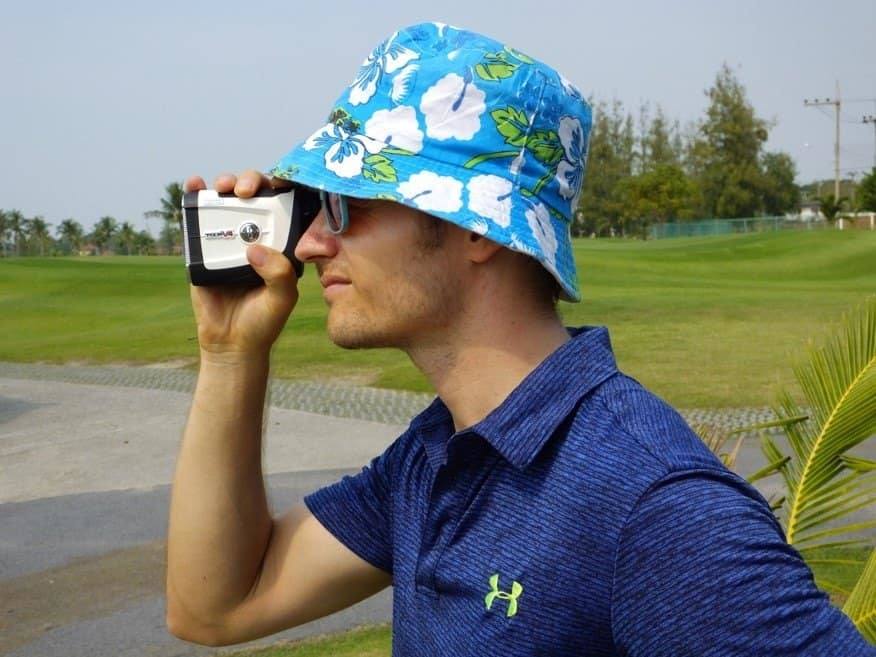
I even tried making my own branded Waddaplaya rangefinder and after all that research and testing, I learned everything about rangefinders and I own 43 of them.
By the way, I didn't make my own rangefinder, because there are so many good models available.
THE BEST GOLF RANGEFINDERS OF 2024
Best Overall Golf Rangefinder – Bushnell Tour Pro XE
BEST RANGEFINDER UNDER $300 – Voice Caddie L6
Best optics - Nikon Coolshot Pro II Stabilized
BEST RANGEFINDER/GPS COMBO - Shotscope Pro LX+
Most high-tech rangefinder – Garmin Approach Z82
Most compact rangefinder - IZZO Swami
Best rangefinder under $150 - Shot Scope Pro L2
What is important in a golf rangefinder?
You must consider 4 important factors for a rangefinder.
- Speed - how quickly does it find the target?
- Accuracy - how easily does it find the correct target?
- Consistency - does the rangefinder give you the same reading to the target over and over?
- Functions - you need a rangefinder with slope mode, and a normal mode only.
Remember these factors while you read about the best golf rangefinders on the market below.
Bushnell Pro XE Rangefinder
The most accurate and reliable distance readings to be 100% certain
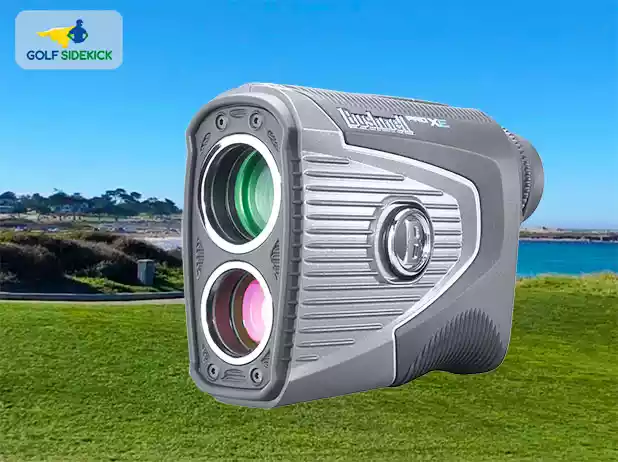
The Bushnell Pro XE is the very best rangefinder I've ever used.
- The XE is totally waterproof.
- 7x magnification is the highest I’ve encountered with an eyepiece that extends and retracts like binoculars by turning the eyepiece.
- Quick and reliable distances to the yard.
- Bright red display and includes so much info to make a decision. The pulsing red ring also ensures you know when it's locked onto the target.
- It will send a vibration into your hand once it captures the distance.
- It has slope function you can easily switch to from normal and back.
The prior model X2 was a bit lighter than the XE but the XE is the most accurate and quick golf rangefinder I have ever tried. My caddie, Bret, at Pebble Beach had one of these on course. I got to use it for 18 holes and I was impressed. Bret told me he had tried many brands but the XE is the most reliable especially in a job where you need fast, accurate distances for golfers paying $600 to play.
It's vivid and clear when you look through the viewfinder. If you do wear lenses or glasses, you should know that it's not as easy to use so you'll need to shift your lenses out the way.
I noticed Bret would shift his sunnies onto his forehead when he used it. I had to do the same but it was quick to shoot a distance to a pin. It's even more impressive that it takes into account elevation, temperature and barometric pressure to give you a 'feels like' distance.
The Bushnell XE is an expensive piece of equipment but if you play a lot of golf or golf at a high level and need very reliable, quick and accurate readings, it doesn't get better than this. It's trusted by the tour pros who work in fractions of a yard.
Overall, the XE is not made for the beginner. If you’re breaking 80 regularly and looking at the low 70s more often, this will be the best rangefinder for you. If you're playing regional and national events, it's a must.
Cons
- My major gripe which stopped me purchasing it though, was that using it with prescription lenses was a pain in the ass. If you don’t wear prescription lenses, this is the best golf rangefinder on the market.
Voice Caddie L6 Rangefinder
The best value golf rangefinder in the world
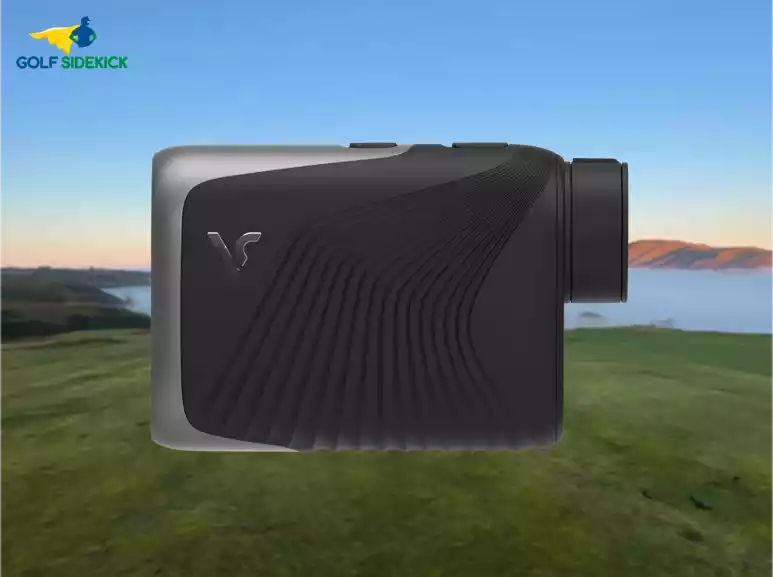
I have been using the Voice Caddie L6 for more than a year and for $199, you will not find a better rangefinder.
- Magnet on the side sticks to the golf cart
- Easily as quick as a Bushnell rangefinder and as consistently reliable
- Bright red display is a drastic improvement on the L5
- Slope function is interchangeable with the Mode button on the top - very easy
- Picks up distances from much further away than any other rangefinder I have used
The construction is always the best giveaway whether a rangefinder is of high quality. VoiceCaddie use excellent materials on the exterior with texture rubber and plastic for a solid build quality. There is no rattling and I would place the true value of this rangefinder at about $350.
My favorite improvement on the prior L5 model is the new red optics in the viewfinder. It's a drastic improvement in being able to pick up targets and read the measurements much more easily. The L6 is also a fraction of a second quicker than the L5 in picking up the target. Having said that, the speed of picking up the target is on par with the Bushnell models and I stand behind that statement after using Voicecaddie products for 3 years.
I play golf with a lot of Bushnell owners and of course I measure all models of rangefinder against the Bushnells. The most impressive feature of the L6 rangefinder is how far away it can pick up pins. I have measured flags from 350 yards away where even a Bushnell cannot pick it up with multiple attempts.
I do find that the L6 is slightly less 'stable' than the L5 because in windy conditions, it takes 2 or 3 attempts to hit the target. The bullseye to pick up the target is slightly larger in the L6. The L5 was a smaller bullseye which made it pick up targets easier.
If you do wear glasses or sunglasses, the eye relief of the L6 is perfect and you will have no issues using it against your lenses. There is a magnet on the rangefinder so you can adhere it to the golf cart. Just don't forget to take it home!
Cons
- You do not see the full bullseye and crosshairs in the optics - I like seeing all the lines but VoiceCaddie are going for a cleaner looking optics.
Nikon Coolshot Pro II Stabilized
Best rangefinder for golfers who have shaky hands
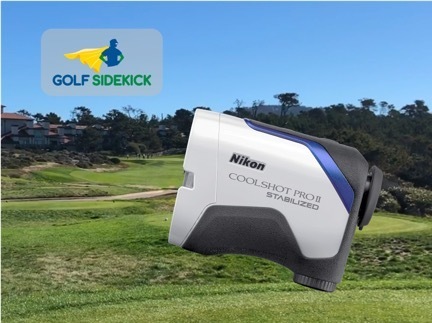
Nikon put the focus of the Coolshot Pro 2 Stabilized in removing the shaking that stops you getting quick readings to the actual target. If you have trouble keeping your hands still while using a rangefinder for anything over 125 yards, this is the one for you.
- Brightness levels of the viewfinder are the best on the market
- Extremely stable for anyone who shakes and can't get readings voer 125 yards
- Readings are done in 0.3 seconds or less
- Red optics in general but when it finds the pin, a bright green ring appears on screen
- Stabilization technology from cameras has been used - full gyro mechanism
- Fog proof and waterproof so use it anywhere anytime
The stabilization is built into the design of the Nikon Coolshot. You get extra help locking onto the target because of a contrasting background on the OLED display. You can hit the pin much easier even if you have something behind the pin distracting your rangefinder and you'll get the reading in a mere 0.3 seconds. It's FAST!
Nikon used technology from their cameras to make the most stable rangefinder ever produced. There is a gyro weight system internally, which makes the rangefinder feel a little lop-sided but after you switch it on, the gyro activates and the stabilization kicks in. If you have shaky hands, using the Nikon Coolshot Pro II will feel like using a fine piece of camera equipment.
The viewfinder optics are some of the best in the business - a bright display with high contrast to pick up targets with ease. If you play in steamy conditions or find rangefinders fogging up, you don't need to worry about that with the Coolshot. It's fog-proof.
There is no magnet on the rangefinder which is a pity but the magnet would affect the stabilization gyro weight system so it is impossible to place one that close to the technology. You can easily fit it inside your pocket and there is no problem laying it down on the dewy ground because the Coolshot Pro 2 is waterproof.
Golf professional Chalisa Lim, one of our Pro golfing review experts uses the Coolshot Pro II Stabilized - she likes that it fits in her pocket and is easy to use for her smaller, shaky hands.
Please note, very important: The rangefinder will feel like there is something wobbling or shaking inside it when you first take it out the box. That does not mean it's broken- it is the gyro weight technology swinging within the rangefinder which initiates when you turn on the unit. DO NOT SHAKE THE RANGEFINDER VICIOUSLY WHEN YOU RECEIVE IT TO CHECK THE LOOSE CONTENTS as you will destroy the rangefinder.
Cons
- No magnet on the rangefinder and the case is not very protective of such a sensitive piece of equipment. I recommend buying a separate case to keep it safe.
Shot Scope Pro LX+
Range finder and GPS combined in one package
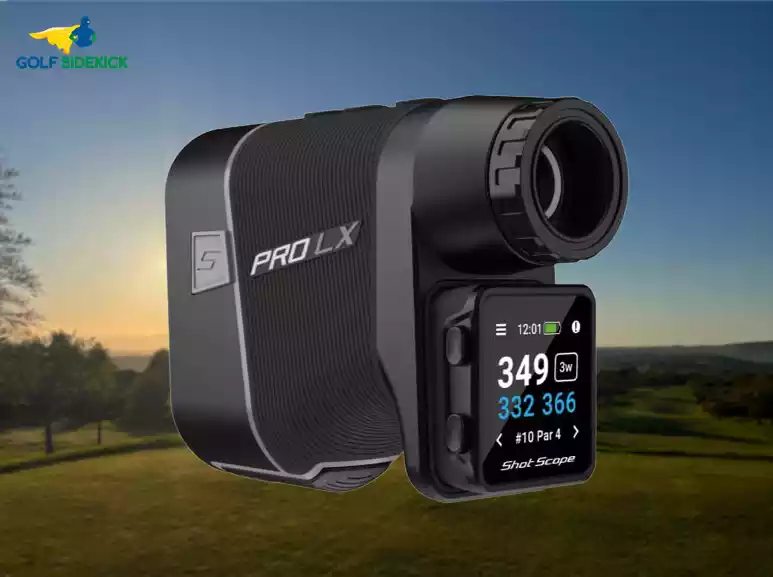
The Shot Scope PRO LX+ is the best laser rangefinder combo on the market. It's a rangefinder with a GPS unit that sticks to it by magnet.
When I received the Shot Scope Pro LX+ for my trip in Scotland, I was surprised how much you get:
- Pro LX Rangefinder
- Shotscope H4 GPS unit with extremely strong magnet as well as magnetic clip
- 16 plastic sensor tags to screw into your grips and tap against the H4 GPS unit to track all your shots!
- Software to download to sync with your device to review your data and statistics
I used the Pro LX+ for a month in Scotland, playing 25 rounds with it and I found these features outstanding:
- Red optics make it very easy to see measurements - sounds minor but it's the biggest improvement I noticed from Shotscope
- The H4 GPS unit tracked all the shots I remembered to tap the sensor for. I forgot a few times so I needed to edit in the app.
- Distances to hazards that you can't see are available on the H4 which is a game changer
- Sturdy and large construction of the rangefinder is solid but the ergonomics are the best in the business to prevent shaking in your hand
- Consistent and accurate readings over and over without problem
I use the rangefinder and GPS unit combo like this: I attached the 16 sensors to the top of my clubs and set up the H4 software. On course, I use the rangefinder for lasering distances and I didn't attach the GPS unit to the rangefinder. I placed it in my pocket instead for quick access to distances when i don't need the rangefinder. I also tapped the sensor against the unit inside my pocket to track all my shots.
I thought I would lose the GPS unit, but I place it into the magnetic hold on the rangefinder after the round wheres it's safe and sound. It never falls off the rangefidner.
I recommend the Pro LX+ package to anyone who needs the whole package: distances to obstacles, distances to the front, middle and back plus distances to hazards that you can't see.
Cons
- The charging cable of the H4 is unique to Shotscope so if you lose it, you will need to buy another from them - it's not a generic USB.
- The bullseye in the viewfinder should be smaller to pick up targets easier in my opinion - it picks up background from beyond 190 yards more easily
- The H4 GPS data needs to be edited after the round because of penalties or if you forgot to tap the sensor.
Garmin Approach Z82 Rangefinder
The most advanced golf rangefinder on the market
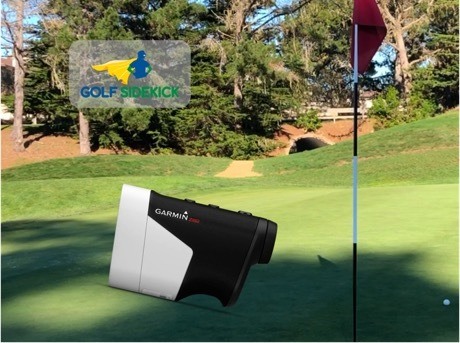
The Garmin Z82 is the best golf rangefinder for total information all in one place. You simply cannot get this level of detail because in the viewfinder, you can see every detail a GPS unit would give you plus you will see a map overlay of the hole you're playing. There is a literal course guide to over 41,000 courses IN THE VIEWFINDER.
I used the Garmin Approach Z82 on a trip to Finland for 7 days of golf. My experience with the Approach Z82:
- The image stabilization rivals the Nikon Coolshot Pro 2 Stabilized making it quick to lock onto the pin
- You can't lose the rangefinder because it has a GPS unit in it so you can track it on your Garmin app
- There's a screen inside the viewfinder, like a video game, showing you the details of the hole - yes it knows 41,000 courses
- You even get wind information on the graphic on screen!
- There is an overlay of a map of the hole you are playing giving you distances to hazards and object on the map
- Along the bottom of the viewfinder, the distances to front, middle and back of the green are displayed.
- The Z82 can identify where you are on any hole at any time and adjusts the map accordingly
- It took me 4 or 5 holes to understand how to use the rangefinder, and the rest of the round to get quick with it without becoming overwhelmed.
- Late in the afternoon and early morning, the viewfinder increases ambient light to help you find the pins in the rangefinder
- You can connect the Z82 to the Garmin golf app and see your scorecard update in real time - you can keep score on the rangefinder!
- Blind shots are easy with the Z82 GPS map - no one else can see what's happening besides you!
- The 'plays like' distance that it gave me was spot on and I picked the right club every time
Give yourself a few rounds to get used to the Z82 because is very different to any normal rangefinder you've had before. There is a lot more information to digest but once you're used to it, you can make informed decisions on the shot. It is simply not even fair to use this device against golfers who don't have it - you're living in the future.
Some golfers might begrudge Garmin for not having a magnet in this rangefinder but that is not possible due to the compass in the GPS unit.
Important: Do not use strong magnets on your cap while if you use the Z82 as it will interfere with the compass and your location. Do not use a magnetic strap around the Z82 either. Keep magnets away from it.
I also recommend getting a backup battery if you go on golf trips and don't want to keep charging the unit every 2nd round. The features suck a lot of juice so you want a back up in case you forget to charge. The one upside is that if you are on a modern golf cart with a USB charger, you can charge it in the cart or with a power bank.
Cons
- Sometimes the Z82 thinks you're on a different hole to the one you're on - it is easy to fix but still annoying. This is common with GPS units.
- The Approach Z82 is charged with a USB cable due to the amount of energy consumed so you need to recharge it with a charger
- Getting to the scorecard feature to check how you're doing is difficult
How to use a rangefinder
You move the rangefinder to your eye like a monocle. There is usually a large button on top of the device that you press once to switch on. Then you place the bullseye in the viewfinder over your target and click the button again. On the screen, the rangefinder will present you the exact distance to that target.
Golf rangefinders are most commonly used to calculate the distance to golf flags only, but they can perform a few more useful functions to take your game to the next level:
Measure your drives

Instead of only measuring distances to the pin, you can also use the rangefinder to determine how long your drives are.
When you're on the tee, pick a tree, or marker or bench in line with the tee box and then once you reach your drive, measure the distance from where your ball is, back to the preselected bench, tree, ball washer, concrete marker. This is the ideal way to know your total distance.
This will help you when you measure a distance to a hazard from the tee and know exactly which club to use because you'll know if the ball will reach it. You’ll be able to swing with total confidence knowing that you’ll be safe.
Learn your carry distances at the range
Measure the distances to pins and distance markers on the driving range and then go through your clubs until you find the club that carries to the pin or distance board. We want to know the carry distance and not the roll-out distance.
This will help you when approaching a green to hit it close to the pin, or when you need to carry a bunker or water. It’s also ESSENTIAL to know your exact distances you hit the ball to achieve lower scores.
Learn your carry distances with your irons on the course
When you play on the course, get the distance to the pin. Hit your shot and then compare where your pitch mark is in relation to the pin. Imagine you are 150 yards from the hole and take an 8 iron. You hit it well and you are short of the pin. How many yards short are you? Subtract that and you will find you hit your 8 iron around 142 yards carry distance.
Can you use this information to say that your 8 iron goes 142 when you strike it well? This is valuable information to use for the rest of your golfing life so you know exactly which distance you hit each club.
What do you see through a rangefinder?
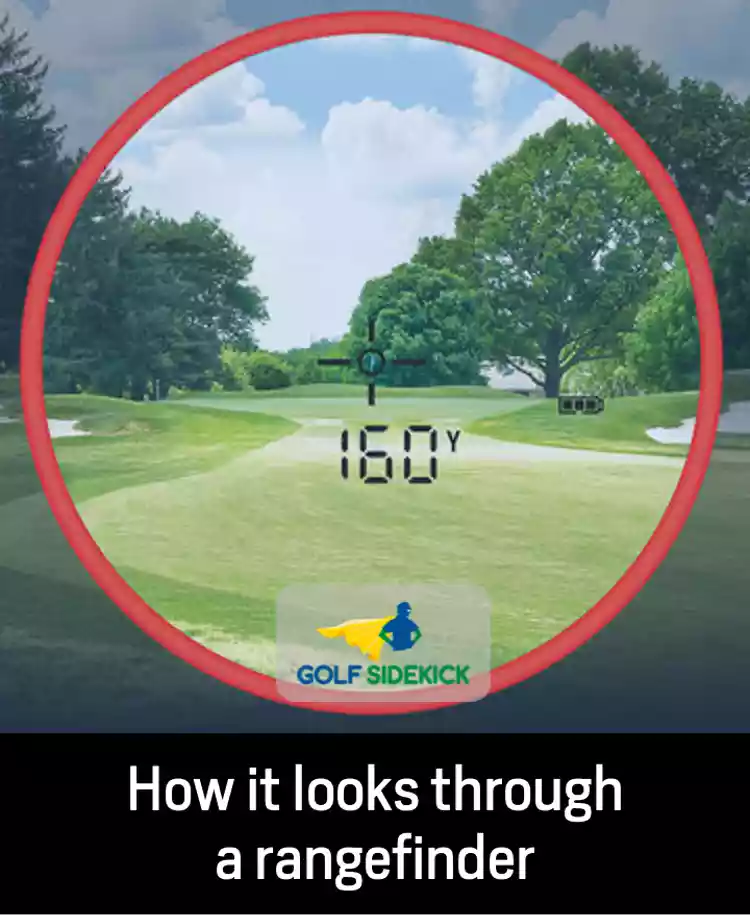
When looking through the rangefinder, you’ll see your target, magnified so it’s similar to looking through a monocular. There’s usually a crosshair in the middle of the display that you point onto the target and when you press a button on the top of the device, a distance will pop up on the display once the rangefinder has settled on how far you are.
The tricky part comes when you have a pin in front of a row of trees because it can be difficult for the rangefinder to pick up the pin. That's why when looking for a rangefinder it’s always good to find one with a technology that finds the pin and puts the priority on the closer object. That’s why I always recommend rangefinders made exclusively for golf - like all the devices in this list.
This is the big difference between hunting and golf laser rangefinders. Hunting laser rangefinders will put the priority on the moving object which is very often behind trees and bushes whereas in golf, the priority is on the item in front of the bushes - the pin.
How accurate is a rangefinder?
Rangefinders are incredibly accurate distance measuring devices and most of the top professionals use them during their practice rounds to calculate the distances so if it's good enough for guys earning millions per shot it's definitely good enough for us.
The only time it’s difficult to use a rangefinder will be when you can’t see the pin because you’re behind trees in the deep trouble.
AVOID: The very cheap models that copy their design and accessories to look similar to the top brands. Unique design on a cheap rangefinder means they put more effort into their product. Anything trying to look like a Bushnell or has a Bushnell style carry pouch will be junk.
What’s the difference between GPS watches and rangefinders?
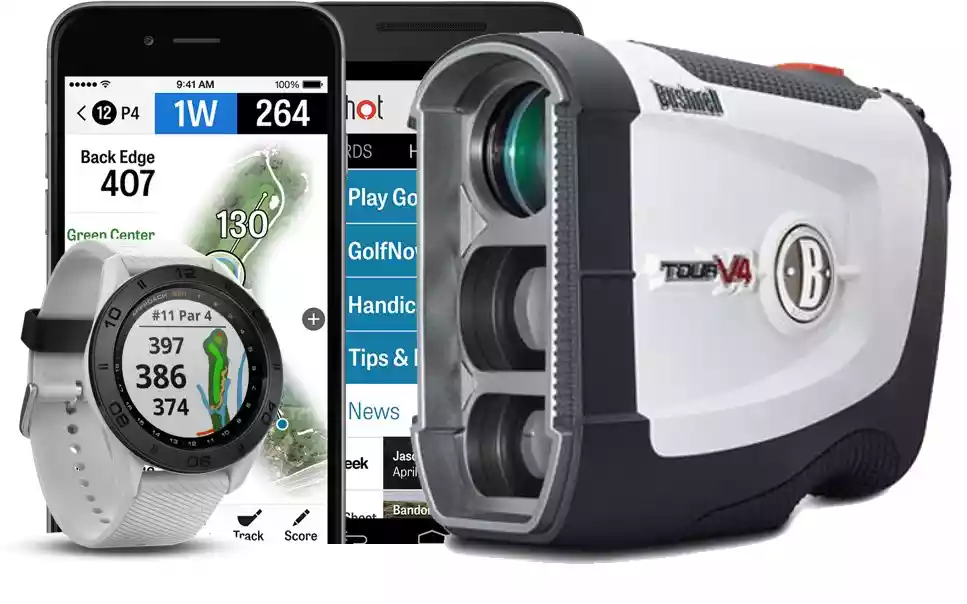
GPS watches use satellites to pick up your location on the course in relation to the middle, front or back of the green. You’ll generally only you get a reading to those three points and in some of the higher end models, you’ll get readings to a selection of hazards.
A rangefinder shoots a laser directly toward your target and once it hits the target it sends back the message to give you the exact distance. These distances are accurate to 1 yard and you can select the target yourself, while GPS gives you distances to spots on the course that you have no control over.
So while a GPS will tell you how far it is to a bunker, it doesn’t tell you how far it is to carry the bunker. A rangefinder allows you the freedom to select the target and get multiple customized targets for distances.
Should I get a rangefinder with slope or no slope?
Almost all rangefinders now come with slope. I would recommend buying a model with the slope function and merely toggle the slope function on and off when needed. If you're going to spend the money, get the maximum and scale back what you don't need. No one ever regretted. buying higher spec.
Which rangefinders to avoid
- Avoid all rangefinders that copy the appearance of the top brands - they are not worth your time.
- Avoid TecTecTec VPro500 - I believe these are loaded with fake reviews and for a few dollars more, you can really get something much better that will last you longer and give you better results.
- Avoid Milessey rangefinders - I have personally used 3 models and 4 friends own these. One of the seven models actually worked consistently with correct distances. Mostly, these models will vary in distance up to 10 yards to the same target and also give you the wrong distance when comparing to Bushnell models.
- Avoid hunting rangefinders - hunting rangefinders prioritize moving objects behind foliage where golf rangefinders prioritizes the items in the foreground, like a flag in front of trees. Hunting rangefinders are not much cheaper so there is no need to try penny pinch and buy junk.
What to look for when trying a rangefinder
Accuracy
You need accuracy to give yourself a committed distance to hit confident shots. Some of the very cheap models can put doubt in your mind because they may laser distances that are not correct in the first place. Better optics and features means better, more accurate distances.
Ease of Use
Mostly you will find a rangefinder has two buttons. one to switch between meters and yards or slope and no slope... and the other is to get the distance.
Usually the button for distances is clicked once and it will find the flag as long as you hold the bullseye on the target steady. Then you can hold the button down to scan. These are the easiest to use and most models go this way.
Distance Range
This one is only important to about 300 yards so you can plan your next 2 shots.
Beyond 300 yards, no one is hitting the green, or making intricate plans on a 400 yard hole. The maximum distance that the manufacturers list is largely for marketing to seem like it's better than the next. You need to have a rangefinder that will be able to pick up the distance from 220 yards at maximum.
Price
You get what you pay for in the optics world, whether it's cameras or telescopes, binoculars or rangefinders. Lower your expectations if you go cheap, and raise your expectations as you go more expensive.
Battery Life
The more features a rangefinder has, the more the battery will die quickly. Most standard rangefinders that provide straight out distances without any special tricks like wind or pressure measurements, will last a long time.
You just need a CR2 battery and it should last one season. You can easily replace it every season for $5.
More labor intensive rangefinders like the approach Z82 come with a USB charging cable and you need to charge it with electricity. Be aware of which you are purchasing.
Water Proof
If you play in watery conditions, this is important. One of the tough ones is humid conditions. Sometimes they may fog up internally and a waterproof one will not do that.
Display Technology
If you are color blind, avoid the red display. Some viewfinders use red digits and this can be bad on green backdrops.
The standard black digits work well and the less clutter the better. Sometimes manufacturers want to put all sorts of stuff on the screen that you don't need. You need a flat distance and a slope distance and that's all.
Viewfinders and displays fall under the optics section so remember: higher price means better optics.
Slope Measurement Capabilities
Get slope.
You can turn it off.
But get it because it will teach you in your normal rounds how much a slope affects the playing distance of the shot. The prices are coming down for everything and no one ever regretted buying higher spec.
Who should buy a golf rangefinder?
Golf rangefinders are suitable for every level of player and there's not a single golfer who won’t benefit from a golf rangefinder.
Benefits of having one of the best golf rangefinders
- Learn the distance you carry every club in your bag
- Calculate true distances in practice rounds before competitions
- Calculate your real driver and fairway wood distances off the tee
- Never be short on an approach again
- Have confidence you know the distance to a hazard and select a club to avoid it
- Essential equipment for breaking 90 and 80
- If you follow a strategy like my breaking 90 or 100 guides and want to calculate distances to split your shots.
Myths about golf rangefinders
“I’m not good enough to get a rangefinder”
No matter what skill level you are, having a range of distances you hit your clubs will help you become a better player. Keeping track in a notebook is helpful over the long term to show you how tight the range between good and bad strikes is.
The key is to understand how far you hit your club MOST OF THE TIME. A lot of golfers will use the distance they hit one ball one time as their benchmark. For example, someone might hit a 7 iron 175 yards once and use that as their 7 iron distance when in reality, they hit the 7 iron 165 yards 80% of the time.
“It slows down play”
It takes no more than 5 or 6 seconds to get the rangefinder out the pouch, shoot the distance and put it back. I usually find the distance while the other guys are still playing.
“I don't need one, I can pace it out”
Good luck. I was one of these people. Then I would ask a friend to tell me the real distance after I spent a minute finding out the distance by pacing 17 yards from the 150 yard marker. I thought it was 133 yards. Well no, Matt, the pin is set on the back of the green and that's adding another 13 yards, so the real distance is 146.
I bought a rangefinder the next day.
“All rangefinders are made in the same factory anyway”
That would be incorrect. You get what you pay for. Go for Milessey and Tectectec and have a world of annoyance. Go for higher or mid range models and you will never look back.
Verdict
Prices are coming down as more competitors enter the market of rangefinders making it one of the best times to buy right now.
You can get a good rangefinder for between $200-250 that works as good as anything on the market.
At $400-550 you get features and more features. Mostly you'll enjoy the pin-lock, vibration, slope function but the speed difference is quite noticeable.
